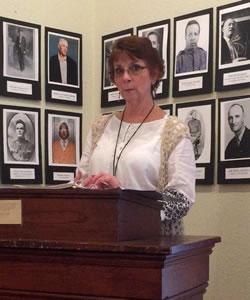 June 7, 2018 - The monthly meeting for the Shelby County Museum was held Tuesday, April 17, 2018 with guest speaker, Terri Lacher. Terri is a native Californian and is a column writer for the Light and Champion. She has also written for the online publication "We the People of Shelby County" and as a freelance writer has stories published in "Chicken Soup".
June 7, 2018 - The monthly meeting for the Shelby County Museum was held Tuesday, April 17, 2018 with guest speaker, Terri Lacher. Terri is a native Californian and is a column writer for the Light and Champion. She has also written for the online publication "We the People of Shelby County" and as a freelance writer has stories published in "Chicken Soup".
She shared with the group the history of the POW Camp in Center, Texas. Of the nearly 70 prisoners of war camps, Texas had approximately twice as many as any other state. Over 50,000 German soldiers were held in Texas during the World War II. While Texas as the choice to house so many prisoners of war may seem odd, the Geneva Convention stated prisoners of war should be housed in a climate comparable to the one in which they had been captured.
The bases in East Texas were called fathom base camps which included Center, Chireno, San Augustine, Lufkin and Tyler. Shelby County is very much like the country side in which these prisoners were captured. The ones that were detained in the East Texas area were part of the General Rommel Afrika Corp. The camps in this area remained opened from about 1942 through 1945 and were the most proficiently run by the German officers themselves. Even though the prisoners could have their own view points, they were very well respectful and grateful they were not being mistreated. If a camp had a trouble maker, prisoner was usually transferred to another camp. The only other time someone might be transferred was if a soldier would find out he had a brother in another camp. Letters would be sent to commanders, so the family members could be together. The United States was very accommodating considering these men were prisoners of war.
One of the biggest problems of WWII was that all our able-bodied men who worked the farms, businesses and forestry were off fighting the war. The prisoners of war could provide labor to the farms, forestry and factories. There were never any problems with the men. Farmers paid the government $1.50 a day for the POW’s labor. Out of this money, the prisoners were paid eighty cents in scrip which was only used at the camp store. During this period, the POWs in Texas picked fruit, harvested rice, cut wood, baled hay, gathered pecans, and chopped cotton.
According to statics, the Center camp had the largest number of soldiers detained in the state of Texas with the numbers running about 700. The camp was located right were the old fairgrounds were. The current location is where the new Portacool park is located and where part of the elementary building is located today.
The camp consisted of several tin buildings surrounded by barbed wire fencing. Each building was built to house cots and a potbelly stove. There were also several outbuildings including a mess hall and a building to treat the soldiers. It was against policy for any prisoner to be treated outside of the facility even though some were treated. During an interview with Dr. Steve Oates, he stated some prisoners were brought to his office for treatment. The camps were well organized and rarely ever had any type of conflict.
After the war several POWs returned to the area. The POWs could do arts and crafts. They were encouraged to do oil paintings; they also had English and engineering classes. Some camps had orchestras and presented theater plays as forms of entertainment. A lot of the POWs were able to take correspondence courses so when they earned their credits and they were able to take them to the universities in German to obtain degrees. Many of the POWs considered the time spend in camps as the best years of their life because of the treatment they received from the Americans.









